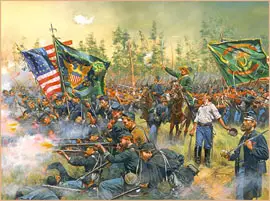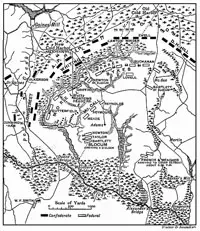Civil War Battles |
Colonial Wars |
American Wars |
Link To This Page — Contact Us —
The Battle of Gaine's Mil
June 27, 1862 in Gaine's Mill, Virginia
 |
|||||||||||||||||||||
|
With Jackson on his right flank and rear, Porter abandoned his strong position behind Beaver Dam Creek during the nightof 26-27 June. Leaving only a rear guard, the large Union corps retreated southward, closer to the bulk of McClellan's Army of the Potomac, located south of the Chickahominy. McClellan reacted defensively to Lee's unexpected offensive by contracting his lines, ordering an evacuation of his supply base at White House, and directing Porter to withdraw to a strong position near bridges across the Chickahominy.
Porter's corps halted on a plateau south and east of New and Old Cold Harbor near Gaine's Mill. He formed a semicirclular defensive line on the plateau behind Boatswain Swamp. Brig. Gen. George Sykes's division manned the right, Brig. Gen. George W. Morell's division held the left, and Brig. Gen. A. McCall's division acted as a reserve. Porter's ample artillery swept the approaches before the strong position.
The Federals waited throughout the morning for the approaching Confederates. When the latter found Porter's empty works at Mechanicsville early on the 27th, Lee pressed his advance, again ordering a convergence on the Union corps. By midafternoon Maj. Gen. Ambrose P. Hill's leading division reached Gaine's Mill and formed. The impetuous Hill then charged the Union position. Across the boggy ground and ravines, the Confederates attacked. The Union infantry and artillery scorched the open ground, repulsing Hill's troops with heavy losses. Some of Hill's brigades made several attacks but failed against the firestorm.
 Click Map To Enlarge |
Maj. Gen. James Longstreet's command arrived on Hill's right, but Lee delayed the assault until Jackson arrived on the Confederate left. Jackson, however, as on the day before, was late. His strange behavior during this campaignhas been ascribed to various causes, but his leadership clearly lacked the fire and skill of his recent Shenandoah Valley Campaign. Delayed by a countermarch, the lathargic general didn't arrive until 3:00 P.M., with his command behind.
By the time he did arrive, Lee had resumed attacks. Hill's division stormed forward on the left only to be swept back by the fire of Sykes's veterans. On the right, Gen. George E. Pickett's brigade suffered heavy casualties in a diversionary attack. Finally, about 7:00 P.M., the Confederates launched a coordinated assault against Porter, who had been reinforced with 1 division. While Longstreet and Hill pressed the Union flanks, the brigades of Brig. Gen. John B. Hood and Col. Evander M. Law pierced the Federal center in a riveting, gallant charge. Porter's line cracked, but the Union troops withdrew in an orderly fashion.
The Federals retreated across the river during the night. Defeat at Gaines' Mill convinced McClellan to abandon his advance on Richmond and begin the retreat to James River. Gaines' Mill saved Richmond for the Confederacy in 1862.
Gaines' Mill was an intense battle, the largest of the Seven Days and the only clear-cut Confederate tactical victory of the Peninsula Campaign. Union casualties from the 34,214 engaged were 6,837 (894 killed, 3,107 wounded, and 2,836 captured or missing). Of the 57,018 Confederates engaged, losses totaled 7,993 (1,483 killed, 6,402 wounded, 108 missing or captured). Since the Confederate assault was conducted against only a small portion of the Union Army (the V Corps, one fifth of the army), the army emerged from the battle in relatively good shape overall. Lee's victory, his first of the war, could have been more complete if it were not for the mishaps of Stonewall Jackson. Historian Stephen W. Sears speculates that it were not for Jackson's misdirected march and his poor staff work, the major assault that Lee unleashed at 7 p.m. could have occurred three or four hours earlier. This would have put Porter in grave jeopardy, without any last-minute reinforcements and the cover of darkness. He quotes Edward Porter Alexander, prominent Confederate artillery officer and postwar historian: "Had Jackson attacked when he first arrived, or during A.P. Hill's attack, we would have had an easy victory—comparatively, & would have captured most of Porter's command."
However, although McClellan had already planned to shift his supply base to the James River, his defeat unnerved him and he precipitously decided to abandon his advance on Richmond and begin the retreat of his entire army to the James. Gaines' Mill and the Union retreat across the Chickahominy was a psychological victory for the Confederacy, signaling that Richmond was out of danger.
